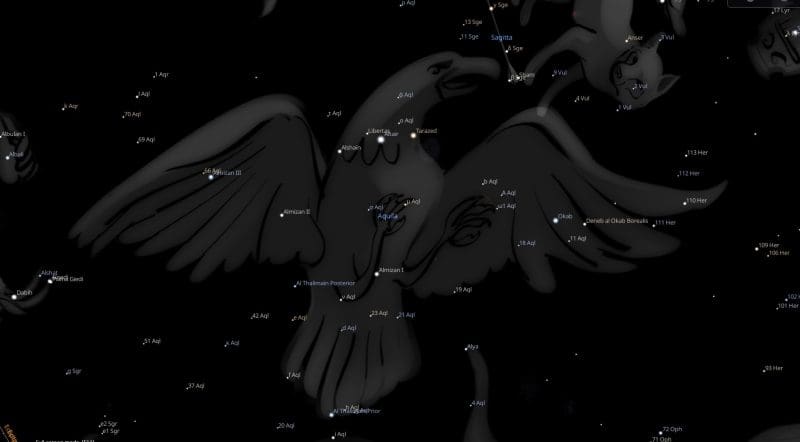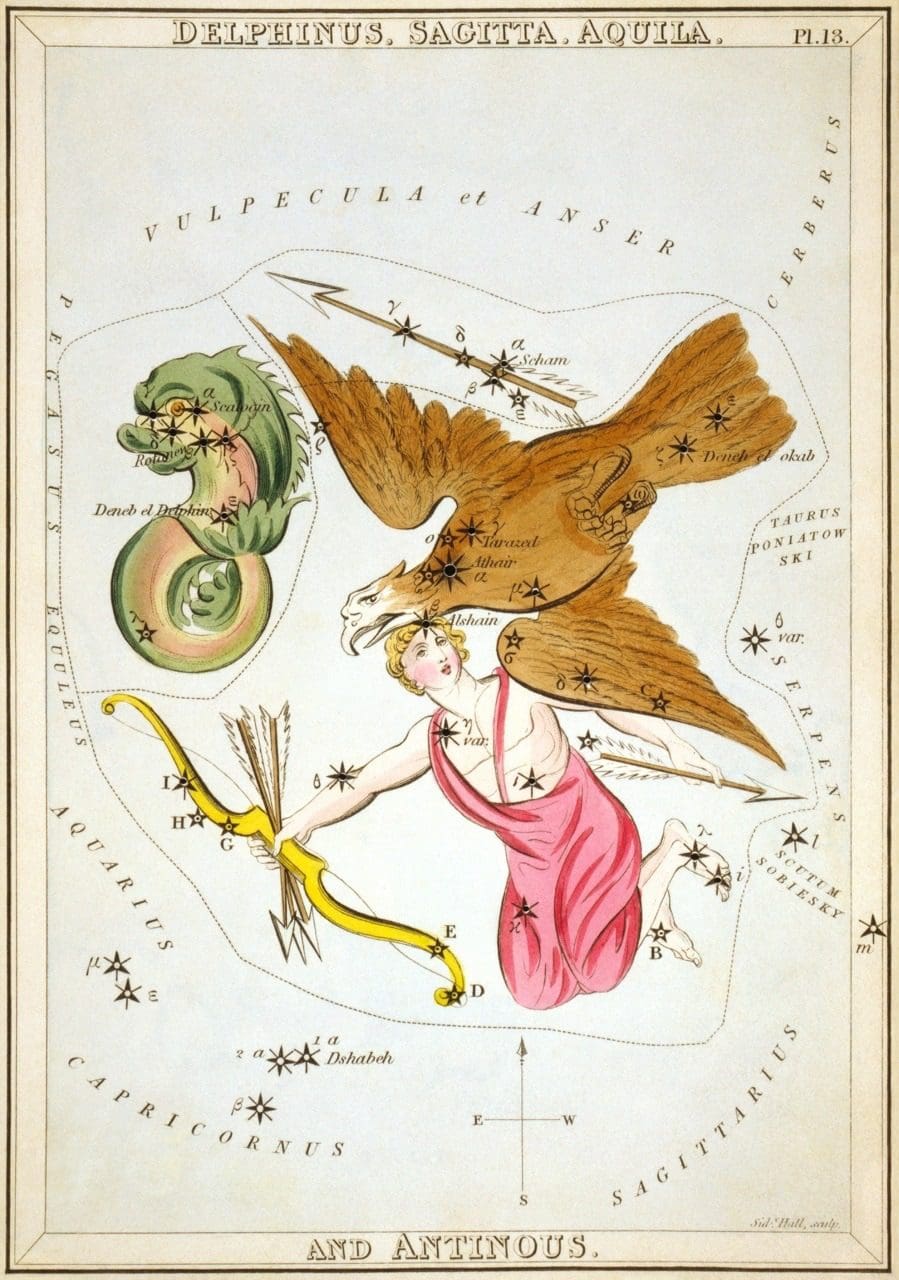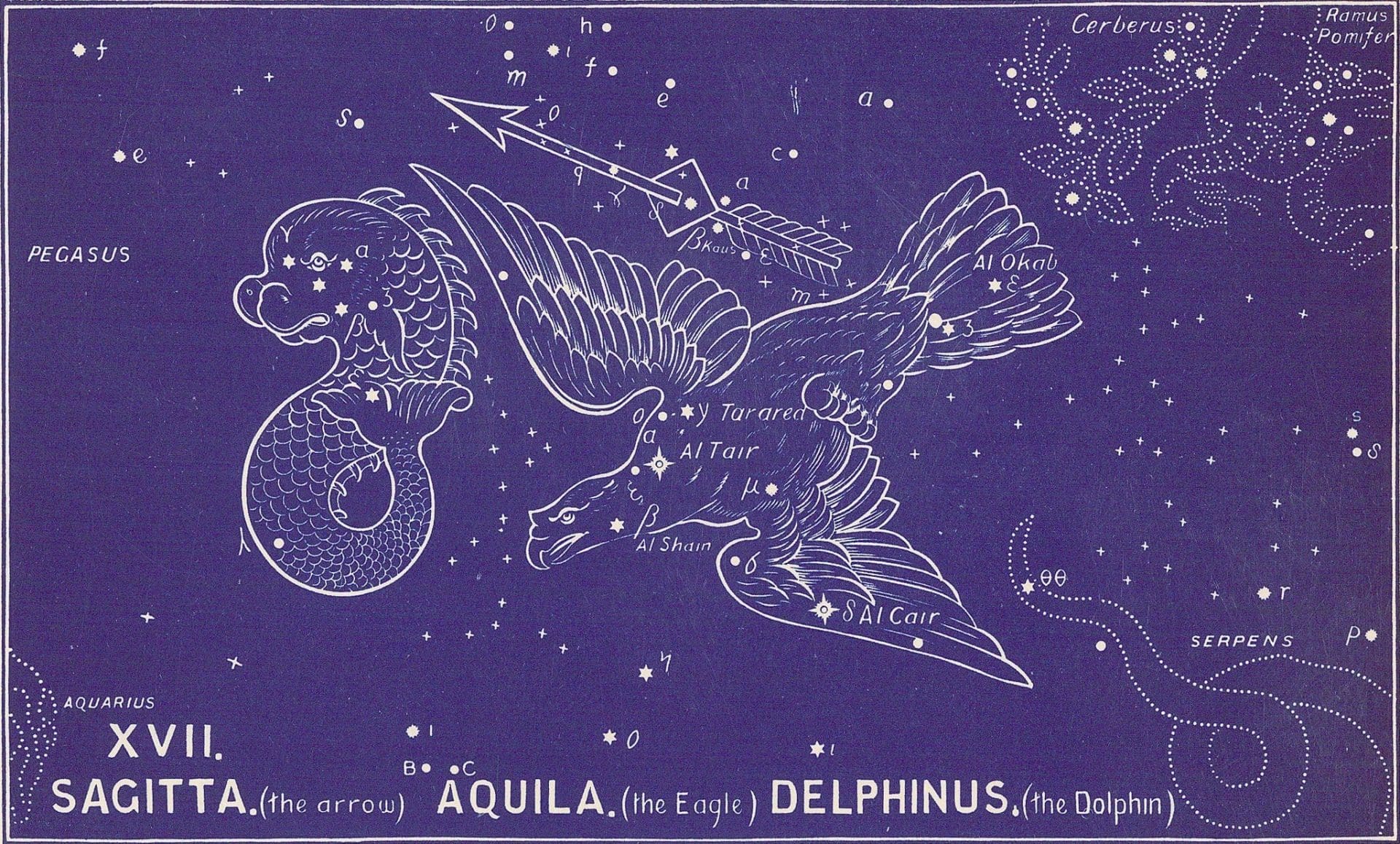FIXED STARS: Major Stars | 1000+ Stars | Constellations | About
Constellation Aquila the Eagle is a northern constellation bordering Sagittarius, Capricornus, Aquarius, Delphinus, Sagitta, Hercules, Ophiuchus, Serpens, Scutum and the obsolete constellations Antinous, Cerberus and Taurus Poniatovii.Aquila is one of the 48 constellations listed by Ptolemy in the 2nd century and remains one of the 88 modern constellations. It spans 26 degrees of the zodiac in the Signs of Capricorn and Aquarius.
Abbreviation: Aql
Genitive: Aquilae
Aquila Constellation Stars
| 2000 | 2050 | Star | Name | Sp. Class | Mag. | Orb |
|---|---|---|---|---|---|---|
| 16♑02 | 16♑45 | i Aql | Bered | K1 | 4.02 | 1°20′ |
| 17♑20 | 18♑02 | λ Aql | Al Thalimain Prior | B9 | 3.43 | 1°40′ |
| 18♑15 | 18♑57 | ε Aql | Deneb al Okab Borealis | K2 | 4.02 | 1°20′ |
| 19♑47 | 20♑29 | ζ Aql | Okab (Dheneb) | A0 | 2.99 | 1°50′ |
| 23♑25 | 24♑08 | ν Aql | F2 | 4.64 | 1°00′ | |
| 23♑38 | 24♑20 | δ Aql | Almizan I | F0 | 3.36 | 1°40′ |
| 24♑51 | 25♑33 | κ Aql | B0 | 4.93 | 1°00′ | |
| 25♑50 | 26♑32 | ι Aql | Al Thalimain Posterior | B5 | 4.36 | 1°10′ |
| 26♑48 | 27♑30 | μ Aql | K3 | 4.45 | 1°10′ | |
| 27♑48 | 28♑30 | σ Aql | B3 | 5.18 | 1°00′ | |
| 00♒25 | 01♒08 | η Aql | Almizan II | F6 | 3.87 | 1°30′ |
| 00♒56 | 01♒38 | γ Aql | Tarazed | K3 | 2.72 | 2°00′ |
| 01♒47 | 02♒29 | α Aql | Altair | A7 | 0.76 | 2°40′ |
| 02♒25 | 03♒07 | β Aql | Alshain | G8 | 3.71 | 1°30′ |
| 02♒38 | 03♒20 | ξ Aql | Libertas | G9 | 4.72 | 1°00′ |
| 04♒55 | 05♒37 | θ Aql | Antinous | B9 | 3.24 | 1°50′ |
| 05♒02 | 05♒46 | τ Aql | Tianfu | K0 | 5.51 | 1°00′ |
| 10♒06 | 10♒48 | ρ Aql | Tso Ke | A2 | 4.94 | 1°00′ |
| 11♒43 | 12♒25 | l Aql | G8 | 4.31 | 1°10′ |
Aquila Astrology
In mundane astrology, Aquila rules the Roman Empire (European Union), the Roman Catholic Church, the Vatican, the United States, space exploration, and weapons, including bombs, missiles, and drones.
Manilius
Then soars to the heights the bird of mighty Jupiter as though, winging its way with wonted effort, it were carrying thunderbolts; it is a bird worthy of Jupiter and the sky, which it furnishes with awful armaments.
The Eagle, soars to the heights, the bird of mighty Jupiter carrying thunderbolts, it is a bird worthy of Jupiter and the sky, which it furnishes with awful armaments. This bird brings back the thunderbolts which Jupiter has flung and fights in the service of heaven. He that is born on earth in the hour of its rising, will grow up bent on spoil and plunder, won even with bloodshed; he will draw no line between peace and war, between citizen and foe, and when he is short of men to kill he will engage in butchery of beast. He is a law unto himself, and rushes violently wherever his fancy takes him; in his eyes to show contempt for everything merits praise. Yet, should perchance his aggressiveness be enlisted in a righteous cause, depravity will turn into virtue, and he will succeed in bringing wars to a conclusion and enriching his country with glorious triumphs. And, since the Eagle does not wield, but supplies weapons, seeing that it brings back and restores to Jupiter the fires and bolts he has hurled, in time of war such a man will be the aide of a king or of some mighty general, and his strength will render them important service. [1]
Robson
Legend. Originally called Vultur Volans or the Flying Grype, Aquila represents the Eagle, thought to be Jupiter himself, that carried Ganymedes to heaven (see AQUARIUS).
Influence. According to Ptolemy the influence of Aquila is similar to that of Mars and Jupiter. It is said to give great imagination, strong passions, indomitable will, a dominating character, influence over others, clairvoyance, a keen penetrating mind and ability for chemical research. It has always been associated with the sign Scorpio, and by the Kabalists with the Hebrew letter Vau and the 6th Tarot Trump “The Lovers.”
Magical. Gives new honors and preserves the old. [2]
Noonan
Aquila (Aql) or the Eagle portends changes in the weather and is indicative of those with a penetrating mind and clairvoyance. Ptolemy says that its stars are of the same nature of Mars and Jupiter, but the brightest stars have the spectra of Mars and Venus. [3]
Allen
Aquila, the Eagle, next to and westward from the Dolphin, is shown flying toward the east and across the Milky Way; its southern stars constituting the now discarded Antinous. Early representations added an arrow held in the Eagle’s talons; and Hevelius included a bow and arrow in his description. Our constellation is supposed to be represented by the bird figured on a Euphratean uranographic stone of about 1200 B.C., and known on the tablets as Idkhu Zamama, the Eagle, the Living Eye.
It always was known as Aquila by the Latins, and by their poets as Jovis Ales and Jovis Nutrix, the Bird, and the Nurse, of Jove; Jovis Armiger and Armiger Ales, the Armor-bearing Bird of Jove in this god’s conflict with the giants; while Ganymedes Raptrix and Servans Antinoum are from the old stories that the Eagle carried Ganymede to the heavens and stood in attendance on Jove. Ovid made it Merops, King of Cos, turned into the Eagle of the sky (he was inconsolable over the death of his wife, and Hera placed him among the stars); but others thought it some Aethiopian king like Cepheus, and with the same heavenly reward.
As the eagles often were confounded with the vultures in Greek and Roman ornithology, at least in nomenclature, Aquila also was Vultur volans, the stars beta and gamma, on either side of alpha, marking the outstretched wings; this title appearing even as late as Flamsteed’s day, and its translation, the Flying Grype, becoming the Old English name, especially with the astrologers, who ascribed to it mighty virtue. [4]
Bullinger
The constellation contains 74 stars. The brightest of them, α (in the Eagle’s neck), is a notable star of the 1st magnitude, called Al Tair (Arabic), the wounding. The star β (in the throat) is called Al Shain (Arabic), the bright, from a Hebrew root meaning scarlet colored, as in Joshua 2:18. The star γ (in the back) is called Tarared, wounded, or torn. δ (in the lower wing) is named Alcair, which means the piercing, and ε (in the tail), Al Okal, has the significant meaning wounded in the heel. [5]
References
- Astronomica, Manilius, 1st century AD, p.31, 341.
- Fixed Stars and Constellations in Astrology, Vivian E. Robson, 1923, p.29, 231.
- Fixed Stars and Judicial Astrology, George Noonan, 1990, p.27.
- Star Names: Their Lore and Meaning, Richard H. Allen, 1889, p.55-56.
- The Witness of the Stars, E. W. Bullinger, 1893, Aquila (the Eagle).


